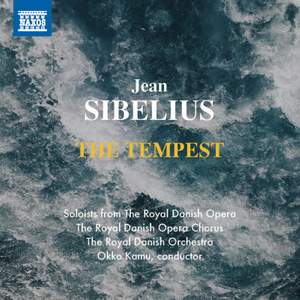
Jean Sibelius (1865-1957)
The Tempest, JS 182 (Op 109) – Incidental Music (1925)
Ariel – Hanne Fischer (mezzo-soprano); Juno – Kari Dahl Nielsen (mezzo-soprano); Stephano – Fredrik Bjellsäter (tenor); Caliban – Palle Knudsen (baritone); Trincolo – Nicolai Elsberg (bass)
Royal Danish Opera Chorus
Royal Danish Orchestra/Okku Kamu
rec. live, 10 October 2021, Opera House, Copenhagen, Denmark
Texts in Danish with English translation included
Naxos 8.574419 [65]
This would appear to be the third modern recording of the complete incidental music to Sibelius’s The Tempest, among the last of the composer’s oeuvre, the other accounts being by Osmo Vänskä on BIS and Jukka-Pekka Saraste on Ondine. Usually one hears the two orchestral suites Sibelius devised from the complete score. They are deservedly quite popular, using at times a different orchestration from that of the full score. For example, Sibelius employs a harmonium in the original instrumentation. In the suites this is replaced by brass and winds, such as in the Chorus of the Winds in Act I. While the suites will undoubtedly retain their popularity, it is good to have another recording of the complete score with its vocal soloists, chorus, and additional music. Both versions are indispensable components of any respectable Sibelius collection.
The most obvious differences I noticed between this new performance of the complete score and the earlier ones are the language of the vocal parts and the very last movement. Whereas Vänskä’s is sung in Finnish, this new one and Saraste’s are in Danish, the language of the work’s world premiere at Copenhagen’s Royal Theatre. The earlier recordings also contain an Epilogue, where the new one concludes with a repeat of Miranda’s music from the beginning of Act I. This reflects the actual music played in that first production. Both conclusions are very brief and a return to Miranda’s slumber music is effective, even if the Epilogue not given here contains music not found elsewhere in the score. The venerable Royal Danish Orchestra whose history, according to the CD booklet, can be traced back to 1448, performs superbly throughout.
Okku Kamu and his Danish forces have the measure of this work, though the other accounts cited above clearly hold their own. If you have either of those, you may not need this one. The recording itself is first-rate with a wide dynamic range. The Overture receives a powerful performance with a most vivid storm—more so than other versions I have heard. The soloists are all excellent and project the text well. Kamu upholds his reputation as a fine Sibelian, having recorded the Tempest suites and a symphony cycle for BIS, as well as recordings of Sibelius for other labels.
In addition to the Overture and the songs, highlights include the Interlude from Act II which portrays Prospero by a “stately sarabande for strings with delectably dancing woodwinds in the middle section, recalling both the burden of the deposed prince and his unassailable position of power on the island” in the words of the booklet writer, Valdemar Lønsted. This music provides more substantial rewards than the much shorter equivalent music in the composer’s later arrangement in Suite No. 2. Also the role of the harp makes a greater impression in the full score, at least as it is recorded here. Likewise, the solo cello in the lyrical and pensive Interlude in Act III, depicting the innocent Miranda, is more prominent in this performance than in other recordings of either version I know. All the dance numbers are splendidly played, too. With Naxos’s attractive price and the booklet containing full texts in Danish and English of the songs and biographical information on the artists, as well as Lønsted’s informative note, this disc should readily enhance any Sibelius collection.
Leslie Wright
Help us financially by purchasing from





















